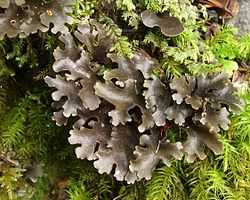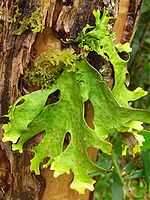Sticta
| Sticta | |
|---|---|
 | |
| Sticta hypochroa | |
| Scientific classification | |
| Kingdom: | Fungi |
| Division: | Ascomycota |
| Class: | Lecanoromycetes |
| Subclass: | Lecanoromycetidae |
| Order: | Peltigerales |
| Family: | Lobariaceae |
| Genus: | Sticta (Schreb.) Ach. |
| Type species | |
| Sticta sylvatica (Huds.) Ach. | |
Sticta is a lichenized genus of fungi in the Lobariaceae family. The genus has a widespread distribution, especially in tropical areas, and includes about 114 species.[1] These lichens have a leafy appearance, and are colored brown or black. Sticta species with cyanobacteria as photobionts can fix nitrogen from the atmosphere, and due to their relative abundance and high turnover, they contribute appreciably to the rainforest ecosystem.
Description
The vegetative bodies of the Sticta, the thalli, are foliose, or leafy in appearance. They typically have dimensions of 2 to 5 centimetres (0.79 to 1.97 in) in diameter, although specimens with diameters of up to 10 centimetres (3.9 in) have been recorded. The lobes are rounded, and the upper surface is black or brown, while the lower surface has a light to dark brown layer of fine hairs (a tomentum), with a few craters, called cyphellae. Thalli often smell of shrimp or fish. The vegetative reproductive structures called isidia or soredia are often present on species in this genus; apothecia (cup-shaped fertile spore bearing structures) are rarely found. Sticta species are usually found growing on bark, wood, or mossy rock.[2]
Habitat and distribution

Most species of Sticta grow on bark, wood, or mossy rock, usually in humid areas.[2]
Sticta species are primarily tropical in distribution, but some species have been reported from as north as Norway,[3] and as far south as the southern tip of South America.[4]
Phylogenetics
Phylogenetic analysis of small and large ribosomal RNA subunits has confirmed that the genus Sticta is monophyletic.[5][6]
Indicators of ecological continuity
Some epiphytic lichen species may be used as "ancient woodland indicators"; they can used to quantitatively assess the degree to which a forest has had a long history of canopy continuity.[7] The presence of these species is a reliable indicator that the forest has existed back to early medieval times, without being clear-cut and regrown. Two Sticta species, namely, S. dufournii or the blue-green algal morphotype S. canariensis, are among several species of lichens that may be used to calculate the New Index of Ecological Continuity (NIEC), considered the most sensitive and accurate determination of forest continuity.[8]
Footnotes
- ↑ Kirk PM, Cannon PF, Minter DW, Stalpers JA. (2008). Dictionary of the Fungi. (10th ed.). Wallingford: CABI. p. 666. ISBN 978-0-85199-826-8.
- ↑ 2.0 2.1 Geiser L, McCune B. (1997). Macrolichens of the Pacific Northwest. Corvallis: Oregon State University Press. p. 277. ISBN 0-87071-394-9.
- ↑ Jørgensen PR. "Sticta dufourii Del. and its parasymbiont Arthonia abelonae P.M. Jørg. n. sp. in Norway". Nova Hedwigia 18: 331–40.
- ↑ Galloway DJ. (1994). "Studies on the lichen genus Sticta (Schreber) Ach.: I. Southern South American species". The Lichenologist 26: 223–82.
- ↑ Miadlikowska J, Lutzoni F., J.; Lutzoni, F. (2003). "Phylogenetic classification of peltigeralean fungi (Peltigerales, Ascomycota) based on ribosomal RNA small and large subunits". American Journal of Botany 91 (3): 449–64. doi:10.3732/ajb.91.3.449. PMID 21653401. Retrieved 2010-03-07.
- ↑ Stenroos SE, Stocker-Wörgötter I, Yoshimura L, Myllis A, Hyvönen TJ., Soili; Stocker-Wörgötter, Elfriede; Yoshimura, Isao; Myllys, Leena; Thell, Arne; Hyvönen, Jaakko (2003). "Culture experiments and DNA sequence data confirm the identity of Lobariaphotomorphs". Canadian Journal of Botany 81 (3): 232–47. doi:10.1139/b03-027.
- ↑ Gilbert, pp. 70–71.
- ↑ Gilbert, pp. 257–59.
Cited texts
- Gilbert OL. (2000). Lichens. London: HarperCollins. ISBN 0-00-220082-1.
External links
- Sticta in Index Fungorum.
| |||||||||||||||||||||||||||||||||||||||||||||||||||||||||||||||||||||||||||||||||||||||||||||||||||||||||||||||||||||||||||||||||||||||||||||||||||||||||||||||||||||||||||||||||||||||||||||||||||
